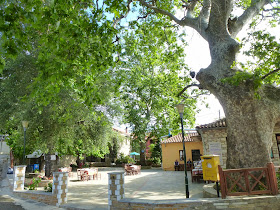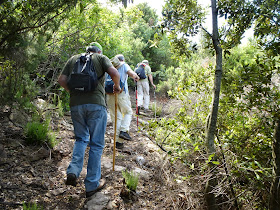Duration: 3 hours (walking time 2.20')
Altitude: from 113 m. (start) to 305 m. (maximum) to 125 m. (end)
Total ascent: 267 m. Total descent: 253 m.
Signed with red paint marks
Drinking water on walk: no
Download GPS track: from Everytrail from Wikiloc
This walk, starting and ending at an arched stone bridge, is part of the old route used by the inhabitants of Kerasia and Veneto in order to go to Volos. It was in regular use until the early 60`s, when the asphalt road was constructed. It is a pleasant walk, without much climbing, amongst shrub vegetation offering little shadow, so it is not recommended for hot summer days unless we start very early. Combined with the walks Louziniko-Kapourna and Kapourna-Kato Kerasia, that makes a 5,5-hour circular walk (best to start from Kerasia). At the square of Kato Kerasia there is a restaurant open all year round. There are regular bus lines connecting Volos to Kato Kerasia (www.ktelvolou.gr).
Our walk starts at the stone bridge of Louziniko, that still remains in excellent condition. This is about 8 km away from the centre of Volos by car or taxi (no bus connection). Driving on Volos ring road (E92) we take the exit to Fitoko and after 1,5 km turn left at the junction on the narrow asphalt to Louziniko.
Just after crossing the main stream of Kserias over the bridge, we take the narrow road to the right, which incorporates twenty metres of the old cobblestone (kalderimi). At the road junction we go straight ahead, parallel to the stream on even ground, without gaining or losing altitude. Eventually the road ends reaching a pen, and we continue gently uphill on a path with some traces of kalderimi. We ignore a narrow uphill path to the left. Overgrown vegetation of kermes oaks (quercus coccifera) intrude and narrow the path at some places. At a V-junction downhill we take the path to the left (the right one going towards Agios Athanasios chapel and Leschiani).
We come down to cross a stream and, climbing on the other bank, we join another stream and follow its course to the north. Further on, as we are on the right bank, there is a path junction. We don`t take the uphill path on the right (going to Agios Athanasios and Leschiani) but keep walking next to the stream and shortly cross it and start climbing on the other side, changing direction to the west. Now we have another ravine on our left side. Looking to the right, we can see the rocky hill called Kokinovrachos (Red Rock).
At the ridge we join an earth road and follow it, passing next to a ruined stone building. There is a large field on our right side. As the road takes a gentle left bend, we leave it and walk on the left edge of that field on a northeasterly direction. In a short while, we continue on a wide downhill path, which follows the course of another shallow stream on our right.
Walking on even ground amongst kermes oak vegetation, we reach a small clearing (called Lakka Psichikou). We join the earth road for twenty metres and then continue on the path on the same direction (attention to the red marks on the right side of the road).
The path opens out to an almond tree grove. We keep to the same northerly direction into the grove. On our left side we can see the main asphalt road. Reaching a small concrete building housing a water drilling, the short section of kalderimi that lies beyond is blocked by dumped soil, so we join the asphalt for 400 m., until we find the path again watching for it on the right side of the road, 20 meters before a road sign indicating a left turn. Further on, the path opens to an earth road and at the following junction we go left (northwest). Just before reaching the asphalt, we don`t walk on this but on the downhill earth track on the right, which becomes a path with traces of kalderimi.
Further down, we come to an earth road and walk over the old stone bridge behind the main church of the village. The kalderimi leads shortly to the square of Kato Kerasia.
 |
| Louziniko stone bridge |
We come down to cross a stream and, climbing on the other bank, we join another stream and follow its course to the north. Further on, as we are on the right bank, there is a path junction. We don`t take the uphill path on the right (going to Agios Athanasios and Leschiani) but keep walking next to the stream and shortly cross it and start climbing on the other side, changing direction to the west. Now we have another ravine on our left side. Looking to the right, we can see the rocky hill called Kokinovrachos (Red Rock).
 |
| The path near Kokinovrachos |
 |
| Walking at the edge of the field |
Walking on even ground amongst kermes oak vegetation, we reach a small clearing (called Lakka Psichikou). We join the earth road for twenty metres and then continue on the path on the same direction (attention to the red marks on the right side of the road).
The path opens out to an almond tree grove. We keep to the same northerly direction into the grove. On our left side we can see the main asphalt road. Reaching a small concrete building housing a water drilling, the short section of kalderimi that lies beyond is blocked by dumped soil, so we join the asphalt for 400 m., until we find the path again watching for it on the right side of the road, 20 meters before a road sign indicating a left turn. Further on, the path opens to an earth road and at the following junction we go left (northwest). Just before reaching the asphalt, we don`t walk on this but on the downhill earth track on the right, which becomes a path with traces of kalderimi.
 |
| Τhe stone bridge at Kato Kerasia |
Further down, we come to an earth road and walk over the old stone bridge behind the main church of the village. The kalderimi leads shortly to the square of Kato Kerasia.



































